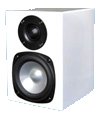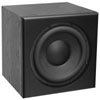Reviews
Linn Helix 11
(no longer in production)
LINN PRODUCTS LTD, FLOORS ROAD, WATERFOOT, EAGLESHAM, GLASGOW
Though not the first model to bear the name, this Helix is an all new design from Linn Products, bearing some striking similarities to the smaller Index II. Both share the same matching stand, for example, the elegant and unusual Kustone stand (so called because of the expanded metal cornposite material that forms its massive central pillar).
Since stand and speaker go together so naturally, it's sensible to regard this as a £466 package, the speaker itself costing £357 (some 50 per cent more than the Index), the stand accounting for the £109 balance.
However, Helix differs from Index and all other Linn speakers to the author's knowledge - in two important respects. First, it's a reflex (port) loaded design rather than a sealed box, and second, it's designed for siting well clear of walls, both factors that will have a significant bearing upon the overall flavour of the sound.
In most respects this is a fairly conventional loudspeaker, a little on the expensive side for the basic two-way configuration and 'large bookshelf' enclosure size, but justifying the premium with slick finish,. and an impressive attention to both presentation and engineering detail.
The box has the usual black vinyl woodgrain over chipboard wrap, while the baffle is more substantiall 18 mm MDF. The drivers are surface mounted using tight bolts and T-nuts, the main driver tensioned by a dense elastic gasket, while gunmetal grey, plastic mouldings cover up all this unsightly engineering, add the slot port and provide the support for the neat frameless stocking mask grille.
The result looks smart and modern with or without the covers in place, while the stand adds a distinctive backwards tilt of a few degrees, allowing the whole thing to be slightly shorter than would otherwise be the case, but adding a few watering problems for houseplant fanciers.
A figure-8 brace stiffens up the enclosure, while a light absorbent fill provides some internal damping. The main driver has a good size magnet, a pressed steel frame and a largish plastic cone, while the tweeter has a small 19mm plastic dome, with short horn flare. A standard PCB crossover has bi-wire terminals and heavy internal wiring feeds the drivers.
Test report
The room averaged traces confirm that the Helix should be placed at least a foot and maybe two or three from the nearest wall. When so positioned the response trace is unusually smooth and balanced by any standards right across the band. By crossing from bass/mid to tweeter at a lower frequency than usual (1.5kHz electrically), the usual presence dip is largely avoided, though the main treble output (3-8kHz) is a little stronger than most and the ultimate H rolloff starting at 8kHz, a shade early.
Compared to the Index, one advantage of the reflex port and larger main driver and box is seen in significantly improved sensitivity. The Helix' 88dB is a shade above average and achieved alongside a very easy load for the partnering amplifier. In this context, the -13dB output at 20Hz represents very respectable bass extension.
Sound quality
With one dissenter who found the relative brightness a little disconcerting, the Helix was very well received by the listening panel, with widespread praise for its open - indeed 'open-mouthed' quality as a stand-out characteristic.
The bass is dry and well controlled, keeping chestiness at bay quite effectively though it is a little lacking in genuine weight, extension and welly. There's not quite the familiar bass slam and authority one has come to associate with Linn's wall-mount, sealed-box models.
However, removed from early wall reflections, colourations across the broad midband are limited to mild pinched and nasal qualities, and the sound is impressively well-timed and coherent, delivering a good measure of immediacy.
When driven hard things hang together pretty well. There's a slightly aggressive edge to this loudspeaker which is always threatening to make its presence felt, making for an exciting if slightly intimidating overall experience. The Helix just about gets away with it when driven from top quality sources and amplification, but can ruthlessly expose any inadequacies further up the chain.
Conclusion
This is a clever design that provides the traditional Linn strengths of speed and coherence in a package that is freed from the inevitable coloration and stereo constraints associated with wall mounting. With the caveat that the experience might be a little too edge-of-the-seat uncomfortable for some listeners and systems, there's no question that the Helix Ku-Stone combo well justifies its premium price and deserves confident Recommendation.
Hi-Fi Choice 103 January 1992






